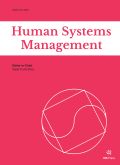Authors: Forouzan, Farkhondeh | Teimouri, Hadi | Safari, Ali
Article Type:
Research Article
Abstract:
BACKGROUND AND OBJECTIVES: The quality of working life in healthcare settings deserves considerable attention due to the vital importance of services delivered in healthcare businesses and organizations, and the direct effect of the employees’ mental and physical health on the chance of medical errors and the quality of healthcare services. Accordingly, leisure time in the workplace and how workers spend their leisure time are significantly influential. PURPOSE: This mixed methods research aimed to develop a model for leisure time management for employees in a selected group of hospitals. DESIGN/METHODOLOGY/APPROACH: The exploratory sequential mixed methods design with
…two phases was used. The qualitative part was based on grounded theory. Qualitative data were identified through 16 semi-structured interviews with selected academic experts and managers of selected hospitals in Shiraz, followed by coding process in three distinct stages. The results were the extraction and design of related categories in the form of causal condition, the central phenomenon, strategies, intervening conditions, contextual conditions, and consequences of employee leisure time management model. After identifying each of the selected template categories, each template element was selected and described in detail during the coding process. The qualitative results were tested in a quantitative section using a researcher-made questionnaire. To do so, 420 study participants were selected. Then, quantitative data and structural equation modeling were analyzed using inferential statistical methods and Amos 22 software, respectively. FINDINGS: Our qualitative data resulted in a conceptual model, design of related categories in the form of causal condition, the central phenomenon, strategies, intervening conditions, contextual conditions, and consequences of employee leisure time management. The quantitative results of the study indicated that the designed model was well fitted and finally confirmed. CONCLUSION: The results of this study reveal that hospital employees, especially therapeutic sections, need high-quality time for leisure and mental, spiritual and physical rest. Yet, time management should be based on special circumstances.
Show more
Keywords: Leisure time, leisure time management, grounded theory
DOI: 10.3233/HSM-200883
Citation: Human Systems Management,
vol. 39, no. 3, pp. 399-412, 2020
Price: EUR 27.50





